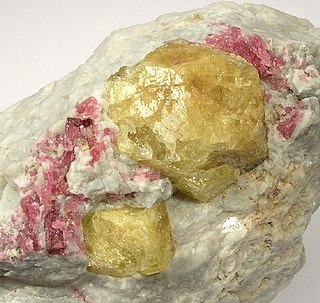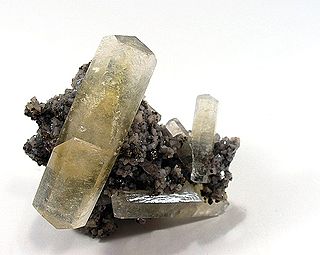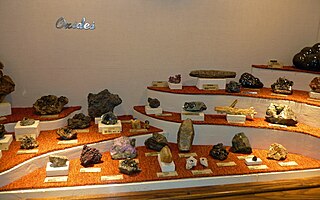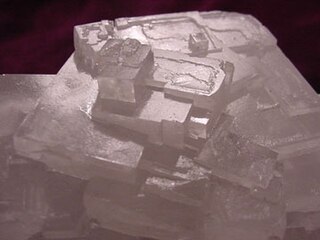The sulfate minerals are a class of minerals that include the sulfate ion (SO42−) within their structure. The sulfate minerals occur commonly in primary evaporite depositional environments, as gangue minerals in hydrothermal veins and as secondary minerals in the oxidizing zone of sulfide mineral deposits. The chromate and manganate minerals have a similar structure and are often included with the sulfates in mineral classification systems. [1]

A mineral is, broadly speaking, a solid chemical compound that occurs naturally in pure form. A rock may consist of a single mineral, or may be an aggregate of two or more different minerals, spacially segregated into distinct phases. Compounds that occur only in living beings are usually excluded, but some minerals are often biogenic and/or are organic compounds in the sense of chemistry. Moreover, living beings often syntesize inorganic minerals that also occur in rocks.

Evaporite is the term for a water-soluble mineral sediment that results from concentration and crystallization by evaporation from an aqueous solution. There are two types of evaporite deposits: marine, which can also be described as ocean deposits, and non-marine, which are found in standing bodies of water such as lakes. Evaporites are considered sedimentary rocks and are formed by chemical sediments.
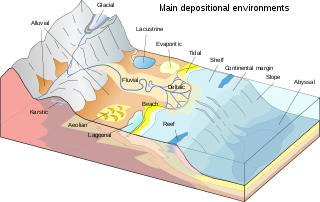
In geology, depositional environment or sedimentary environment describes the combination of physical, chemical and biological processes associated with the deposition of a particular type of sediment and, therefore, the rock types that will be formed after lithification, if the sediment is preserved in the rock record. In most cases the environments associated with particular rock types or associations of rock types can be matched to existing analogues. However, the further back in geological time sediments were deposited, the more likely that direct modern analogues are not available.
Contents
- Nickel–Strunz classification -07- sulfates
- Class: sulfates, selenates, tellurates
- Class: chromates
- Class: molybdates, wolframates and niobates
- References


Sulfate minerals include:
- Anhydrous sulfates
- Hydroxide and hydrous sulfates
- Gypsum CaSO4·2H2O
- Chalcanthite CuSO4·5H2O
- Kieserite MgSO4·H2O
- Starkeyite MgSO4·4H2O
- Hexahydrite MgSO4·6H2O
- Epsomite MgSO4·7H2O
- Meridianiite MgSO4·11H2O
- Melanterite FeSO4·7H2O
- Antlerite Cu3SO4(OH)4
- Brochantite Cu4SO4(OH)6
- Alunite KAl3(SO4)2(OH)6
- Jarosite KFe3(SO4)2(OH)6

Gypsum is a soft sulfate mineral composed of calcium sulfate dihydrate, with the chemical formula CaSO4·2H2O. It is widely mined and is used as a fertilizer and as the main constituent in many forms of plaster, blackboard chalk and wallboard. A massive fine-grained white or lightly tinted variety of gypsum, called alabaster, has been used for sculpture by many cultures including Ancient Egypt, Mesopotamia, Ancient Rome, the Byzantine Empire and the Nottingham alabasters of Medieval England. Gypsum also crystallizes as beautiful translucent crystals of selenite (mineral). It also forms as an evaporite mineral and as a hydration product of anhydrite.

Chalcanthite, whose name derives from the Greek, chalkos and anthos, meaning copper flower, is a richly colored blue/green water-soluble sulfate mineral CuSO4·5H2O. It is commonly found in the late-stage oxidation zones of copper deposits. Due to its ready solubility, chalcanthite is more common in arid regions.
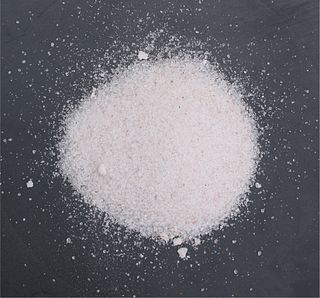
Kieserite is the magnesium sulfate mineral (MgSO4·H2O) and is named after Dietrich Georg von Kieser (Jena, Germany 1862). It has a vitreous luster and it is colorless, grayish-white or yellowish. Its hardness is 3.5 and crystallizes in the monoclinic crystal system. Gunningite is the zinc member of the kieserite group of minerals.
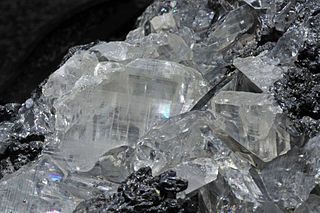
Anglesite is a lead sulfate mineral with the chemical formula PbSO4. It occurs as an oxidation product of primary lead sulfide ore, galena. Anglesite occurs as prismatic orthorhombic crystals and earthy masses, and is isomorphous with barite and celestine. It contains 74% of lead by mass and therefore has a high specific gravity of 6.3. Anglesite's color is white or gray with pale yellow streaks. It may be dark gray if impure.

Anhydrite, or anhydrous calcium sulfate, is a mineral with the chemical formula CaSO4. It is in the orthorhombic crystal system, with three directions of perfect cleavage parallel to the three planes of symmetry. It is not isomorphous with the orthorhombic barium (baryte) and strontium (celestine) sulfates, as might be expected from the chemical formulas. Distinctly developed crystals are somewhat rare, the mineral usually presenting the form of cleavage masses. The Mohs hardness is 3.5, and the specific gravity is 2.9. The color is white, sometimes greyish, bluish, or purple. On the best developed of the three cleavages, the lustre is pearly; on other surfaces it is glassy. When exposed to water, anhydrite readily transforms to the more commonly occurring gypsum, (CaSO4·2H2O) by the absorption of water. This transformation is reversible, with gypsum or calcium sulfate hemihydrate forming anhydrite by heating to around 200 °C (400 °F) under normal atmospheric conditions. Anhydrite is commonly associated with calcite, halite, and sulfides such as galena, chalcopyrite, molybdenite, and pyrite in vein deposits.
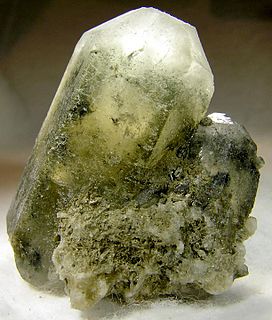
Hanksite is a sulfate mineral, distinguished as one of only a handful that contain both carbonate and sulfate ion groups. It has the chemical formula Na22K(SO4)9(CO3)2Cl.





